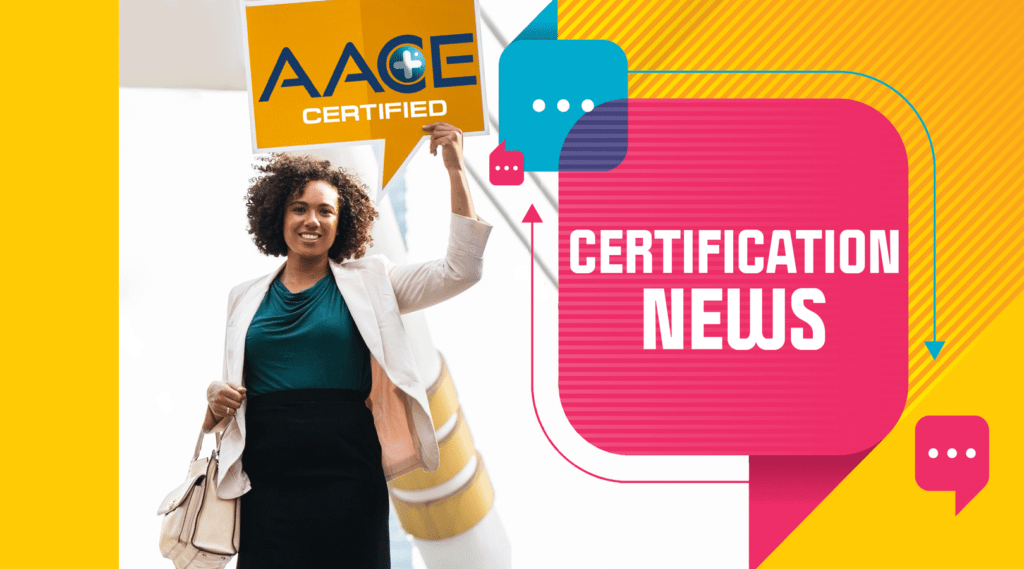Certification Department Shares Insights from 2024 I.C.E. Exchange
The AACE Certification Program Staff recently attended the 2024 Institute for Credentialing Excellence (I.C.E.) Exchange in Miami, Florida, from November 17th to 20th.
I.C.E. is a professional membership association that provides education, networking, and other resources for organizations and individuals who work in and serve the credentialing industry. It is a leading developer of standards for certification and certificate programs and a provider of and a clearinghouse for information on trends in certification, test development, and delivery, assessment-based certificate programs, and other information relevant to the credentialing community.
The Exchange offered sessions covering the following tracks:
- Beyond Traditional Credentials
- Business of Credentialing
- Credentialing Innovations
- Data Management, Privacy, and Test Security
- Marketing and Communications
- Standards and Accreditation
- Test Development and Administration
Each Certification staff member has provided a take-away summary of one session that challenged, intrigued, or excited them.

Sara Peters, Credentialing Analyst
Attending the pre-conference workshop, “The Business of Certificates, Microcredentials, and Professional Education Programs,” at the 2024 ICE Exchange highlighted opportunities for AACE to expand educational offerings and better prepare candidates.
The workshop emphasized how certifications are essential for setting professional standards, validating skills, and helping individuals advance their careers. AACE’s certifications are backed by rigorous assessment practices, ensuring credential holders demonstrate the knowledge and abilities needed to succeed. Maintaining this credibility and rigor remains a top priority as the credentialing field evolves.
Unlike micro-credentialing and Assessment-Based Certificates (ABCs), which focus on specific skills or topics, certifications provide broader validation of expertise and often require ongoing education or recertification. These emerging models, however, offer flexible, targeted learning pathways that could complement AACE’s certification programs by addressing focused skill development.
The session also underscored the importance of designing credentialing programs that prioritize the learner’s experience. This includes competency modeling, skill mapping, and clear assessment blueprints. Strategic alignment with organizational goals and continuous feedback loops ensure that programs remain relevant and valuable to both learners and stakeholders.
Reflecting on the session, I’m inspired by the potential to innovate AACE’s educational offerings. Incorporating new educational models and refining our strategies can enhance our value and ensure we continue to meet the needs of a rapidly changing workforce. This experience reaffirmed my confidence in AACE’s leadership and its ability to adapt and grow.

Valerie Smith, Senior Credentialing Analyst
As a self-proclaimed candidate advocate, I attended an insightful session titled “The Responsibility of the Testing Industry to Understand and Address Test Anxiety Among Test Takers” at the recent I.C.E. Exchange. This session addressed the challenges of test anxiety and provided some ideas for combating it.
We talked about how test anxiety affects people’s minds and bodies and how it can hurt their test performance. One important concept discussed was cognitive load, which is the intense anxiety that can cause someone’s mind to freeze and affect test results.
We explored strategies to reduce test anxiety, focusing on how the testing industry can create supportive testing environments. Here are some of the ideas:
- Exam Sandbox: We explored ways to help candidates prepare for the user experience, including creating an exam sandbox environment. A significant source of test anxiety for candidates often stems from not knowing what to expect or how the system will function. This sandbox would allow candidates to familiarize themselves with the testing environment. It could demonstrate how to access test aids, such as scenarios, memos, and equation/formula sheets; how to contact the proctor for questions or breaks during online proctored exams; and what the questions will look like on the screen.
- Online Proctored Exams (OLP): Taking OLP exams can be a great option, but it also comes with its own set of potential complications. First, candidates do not have the advantage of having someone onsite to provide technical assistance. AACE’s certification staff cannot help during the exam because the testing platform does not belong to us. Instead, candidates must rely on the proctor for assistance via their computer.
Additionally, interruptions from the proctor can create added stress, especially if candidates are unaware that they are doing something that may trigger an interruption. For instance, some candidates may unconsciously move their eyes to the side or fidget when thinking, which can lead to a proctor’s intervention.
Another common issue arises when candidates take their exams at home, where the presence of children can be distracting. While being in a quiet space is advised, controlling a child’s behavior is not always possible. For example, if another parent is in the background speaking to a child who has wandered into the exam space, it could potentially cause problems during the exam.
Awareness of these factors can help alleviate some unnecessary stress associated with OLP exams.
- Accommodations Process: I am pleased that we have recently reviewed our accommodations process to ensure it aligns with the spirit of the Americans with Disabilities Act (ADA). We aim to provide thoughtful support for candidates worldwide while honoring diverse guidelines. This is an excellent start.During this session, the panelists emphasized the importance of reassessing the application process for accommodations. For example, suppose someone applied for accommodation five years ago to manage their diabetes by allowing snacks, drinks, and medication during an exam. In that case, it is unlikely that their condition will change if they take another exam today. Therefore, requiring them to reapply and undergo the added stress of visiting a doctor and gathering documentation again would be unnecessary. Additionally, the panelists discussed innovative ways to evaluate requests related to neurodiversity.
Along with the rest of the certification team, I am dedicated to creating a welcoming and supportive atmosphere for candidates so they can have a positive testing experience. I’m excited to explore different strategies to help ease test anxiety and boost confidence and calmness for everyone taking a test.

Penny Whoolery, Director: Certification & Membership
At the 2024 Institute for Credentialing Excellence (ICE) Exchange, I attended a workshop on “Developing Strategies and Governance for Incorporating Artificial Intelligence.” The workshop piqued my interest because of the surge in Artificial Intelligence (AI) utilization when writing text, data analysis, or creating images or videos for everyday tasks, which is quickly creeping into the credentialing space. I am intrigued by the power of AI but equally concerned about the potential risks and unintended consequences of incorporating AI into a high-stakes credentialing program.
Three attorneys who specialize in the education and assessment industry led the workshop. They provided real-life case studies to help attendees understand the potential harm from irresponsible or abusive technology use and to provide legal and governance frameworks to mitigate those risks.
The common questions many testing programs ask when considering adopting AI are:
- How can a testing program best determine how and when to incorporate AI?
- What key considerations should be fleshed out when building an AI strategy?
- What governance and policies should be implemented when incorporating AI?
Through presentation, discussion, and small group breakout sessions, we addressed building a strategy, identifying risks, and designing a framework for effectively leveraging AI.
The main takeaways can be summed up with three Ps:
- Be proactive: AI is at our doorstep and is not going away. However, it is important not to fall into the trap of allowing AI to be used without guardrails and direction for the association. For example, using open AI to create examination questions creates greater examination security risks because of the far-reaching exposure in an open environment. In one case study shared by the presenters, AI has been known to create questions with biased or insensitive content inadvertently.
Creating a Governance Team within the organization was recommended to oversee and develop AI principles and policies. Until they can determine the best way to implement AI and develop an Acceptable Use of Artificial Intelligence Policy, developing and implementing an Artificial Intelligence Restriction Policy is highly recommended to ensure all stakeholders are refraining from using AI in a manner incongruent with what the association deems acceptable.
- Be Playful: We don’t need to be afraid of AI; we only need to be cautious. Due to the confidential nature of examination content and intellectual property, it is recommended to use a closed or enterprise version of AI. Some AI providers offer a trial period, which can be used as a sandbox to “play” in. This “play period” allows us to try before we buy and gives the AI Governance Team real-life exposure to the pros and cons of AI, which will be useful in developing and implementing a well-thought-out acceptable use policy.
Having a pilot program to test AI implementations on a small scale to evaluate feasibility and impact before full deployment has also proven to be effective.
- Be Planful: A good plan goes a long way in ensuring success. The expert presenters recommended the following steps:
- Clarify your business needs. What does success look like to the association? Allowing staff or volunteers to use AI that does not align with an Acceptable Use Policy puts the association at risk and could have reputational, financial, or legal consequences. An AI plan must focus on what is best for the association, not individuals.
- Identify technical complexity, risk, impact, and resources. They also recommended keeping our members and certificants informed, especially if it involves their data.
- Select and train the model. The “playful” period should help find the right AI program for the association’s needs.
- Prepare and deploy. If planned and executed properly, AI can be a powerful and effective tool for meeting the association’s needs.
Artificial intelligence was a major topic for several sessions at the 2024 ICE Conference and the ASAE Conference I attended in August 2024. This demonstrates that AACE is not the only association discussing and debating the usefulness and power of AI and how to use it effectively; everyone in the association space is looking for guidance.
I am thankful for the opportunity to learn from subject matter experts on this important, ever-changing topic. I walked away with a better understanding of AI and the need for a strategy and plan before incorporating it into our association.
The next ICE Exchange will be held in Phoenix, AZ, on November 15-20, 2025. To learn more about I.C.E., check out their website by clicking here.
Rate this post
Click on a star to rate it!
Average rating 0 / 5. Vote count: 0
No votes so far! Be the first to rate this post.

